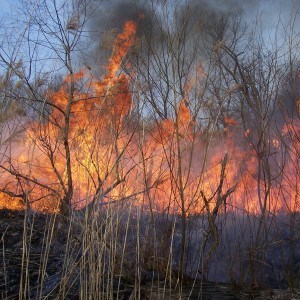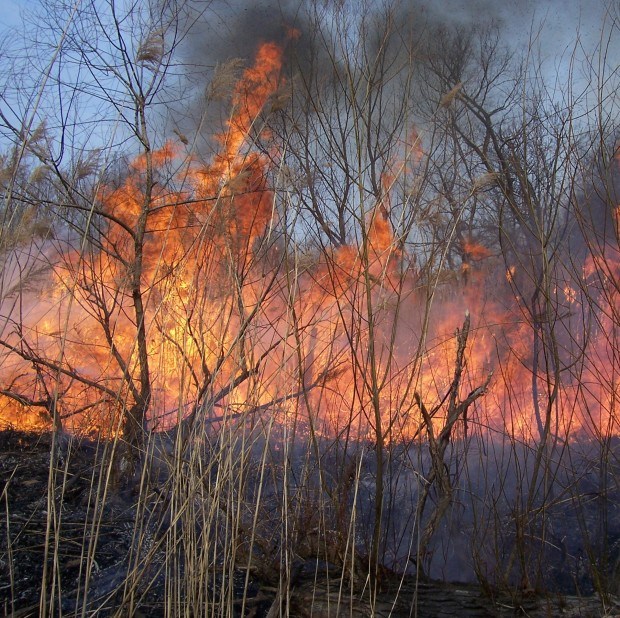Spring’s not even over and already wildfires have raged in California, New Mexico and Oregon this year. A bulletin issued by the National Interagency Fire Center forecasts above normal fire potential from April to June 2014 in western states due to severe to exceptional drought conditions. The bulletin also noted that warmer than normal conditions were expected in the Southwest.
 Drought conditions remain the main factor in determining fuel conditions. In fact, the U.S. Drought Monitor reports that more than 50 percent of the country is in a state of drought.
Drought conditions remain the main factor in determining fuel conditions. In fact, the U.S. Drought Monitor reports that more than 50 percent of the country is in a state of drought.
According to Tom Jeffery, senior hazard scientist with CoreLogic, wildfire hazard is driven by three stable forces: vegetation, terrain and slope.
“We look at the fuel, which is really looking at vegetation, and we look at the terrain because slope and the facing direction of the slope, which is known as aspect, have a pretty significant role in determining what’s a hazard,” said Jeffery. “Based on those three criteria, we do not see a tremendous change from year-to-year. However, with that said, we do see the variable come in that…is short-term climate, which in this case means drought.”
Terry Taylor, fire captain for the East Fork Fire District in Minden, Nev., said the cause of wildfires depends on the location.
“In the true wildlands, the typical cause is going to be lightning, whereas as soon as you get into the urban interface stuff, it tends to be more man-caused,” said Taylor, who also works as an independent fire investigator.
“The types of things that we see are fireplace ashes placed outside. Fireplace ashes can sit for as long as six months and be hot. We had a fire like that two years ago, the Washoe Lake fire, that killed a person and burned down 15-20 homes. That was just fireplace ashes in the wind. They were like a month old,” Taylor said.
Construction activity is another source of ignition.
“When you’re using backhoes, blades of tractors, and you’re plowing your way through granitaceous rock and dry grass, the steel hits the rock and makes a spark. If the weather conditions are correct, you get ignition,” the Nevada fire investigator said.
Shooting is another cause of wildfires.
“It’s been a surprising cause of fires—people shooting out in the wildland urban interface in areas with dry grass,” said Taylor.
He said the aging electrical power line transmission infrastructure can also be blamed for starting some significant wildfires.
How a wildfire starts is important, but the real issue involves the heightened level of risk for damage, one expert said.
“Yes, the ignition sources are always a concern. The bigger issue is the risk is higher. You have more people living in proximity of that risk,” said Carole Walker, executive director of the Rocky Mountain Insurance Association.
“Beyond the cause of ignition, I think the big concern and threat increase has been that perfect storm of factors at play, that recipe for disaster. More and more people living in what we call the wildland urban interface, or the WUI,” said Walker said. “More people building their permanent primary residences in high-risk wildfire areas and overforestation. Our forests are bigger with more vegetation than they were a century ago. Those factors create the higher risk.”
Another factor is the growing size and value of homes located in WUI regions. Now there are multimillion-dollar homes, where in the past there might have been only small cabins in the woods.
A resurgence of building has led to higher risk, according to Jeffery.
“Back in 2008, 2009, because of the economic downturn, we saw a retraction in new home development. We didn’t see a lot of new construction going on. The real estate economy took a downturn. We’ve seen a rebound from that,” he said.
“Now we’re getting more new development that’s continuing that trend of pushing out from urban areas. Those homes or subdivisions are actually pushing up against and out into what formerly was in many places, especially California, what we call wildland,” the CoreLogic scientist said.
Jeffery explained that wildland areas, which typically have higher fuel concentrations, have the potential to be high wildfire risk.
Walker said that close to 84 percent of undeveloped WUI still exists, but builders and would-be residents are already eyeing the undeveloped land.
“We know there is a potential for even larger, multibillion-dollar wildfire disasters. At this point, they haven’t been as widespread as the hurricanes that we’ve seen. At the same time, you still had 347 homes burned in the Waldo Canyon fire. They were people’s permanent, primary homes. We estimate the damage of that at about $576 million,” Walker said.
Wildfire Damage Mitigation
Colorado—one state that has seen two of the most expensive wildfires in history—is considering adding more money for wildfire prevention and mitigation, Walker said.
The president’s 2015 budget included protection of wildfire prevention programs. According to Colorado Sen. Mark Udall, the budget would include provisions that treat wildfire-fighting efforts separate from ongoing prevention efforts.
“With the rise of modern mega-fires in Colorado and across the West, federal firefighting agencies have been forced to raid forestry programs that could help prevent future fires. This destructive cycle of robbing Peter to pay Paul leaves Coloradans exposed to wildfires and only invites future catastrophic mega-fires like the Waldo Canyon Fire, the High Park Fire and the West Fork Complex Fire,” Udall said.
Earlier this year, Udall, introduced bipartisan legislation that would allow FEMA to work with states and affected regions on wildfire mitigation projects.
Walker said there is a definite emphasis on mitigation by insurers.
“Over the past decade, increasingly they [insurers] have gotten stricter about what they’re willing to insure and are asking homeowners to share that risk, either when they buy a policy or renew—that they need to do A, B, C and D,” Walker said. This might include “everything from moving wood panels away from the house to thinning trees to having defensible space.”
Insurers consider factors like the distance between a home and a fire station, the slope of a home, and whether access roads exist. Insurance companies also have mitigation programs, do more onsite inspections and use wildfire modeling information to anticipate risk before a wildfire occurs.
By and large, wildfires are an insured catastrophe, as long as an insured has kept up with limits, endorsements and building codes, Walker said.
“Here in Colorado, the emphasis has been on requiring mitigation. At the same time, if you live a long distance from the fire department in no-man’s land or you’re on a high mountain slope, then you may have difficulty finding insurance. In most cases, you can still find insurance in Colorado even if you live in a high-risk wildfire area, if you’re willing to share that risk, take those mitigation steps,” Walker said.
Need for Investigation
Wildfires need to be investigated to determine the cause and whether subrogation against at-fault parties exists, the experts said.
It’s helpful to have an attorney involved early, said Kevin Bush, the office managing partner at the San Diego law firm Cozen O’Connor.
“In these kinds of specialized areas, it’s helpful to have an attorney involved early, both to help evaluate whether it’s one where it looks like there may be some possibility for subrogation, and if there is, then to get the appropriate experts involved,” Bush said.
Adjusters should consider the qualifications of an origin and cause investigator as well.
“You should ask if the person has completed FI210, which is the nationally recognized course of study to determine the origin and cause of wildland fires. There are private sector people that have completed it,” Taylor said. “The fire department responding has the duty under law to do an origin and cause investigation, but depending on where you are, you may not have anybody trained in it.”
Bush said that some losses like lightning aren’t likely to yield any recovery. The same holds true for an individual who may not have the resources to satisfy all of the claims that could arise from the scope of the damages caused by a wildfire.
Bush said other experts in engineering and surveying may need to be retained too. “There’s a number of reasons why it’s good to get the team together early if it’s a viable claim or looks like it has the possibility to be,” the subrogation attorney said.
According to Taylor, damages tend to be very severe in a wildland fire that involves multiple structures.
“The subrogation cases that I see making their way through the courts are mostly against larger corporations that obviously have a deeper pocket—the big construction guys that get something going when they’re doing work out there, or the utility companies, the electrical power guys. There’s a lot of litigation,” said Taylor.
Bush said that when there are several parties involved, it’s helpful to get an investigative team together early on in the wildfire investigation.
“They [adjusters] should work on putting a team together to assist them with the cause part. The adjusters have a lot of responsibilities on those multiple property losses on the adjustments and taking care of the needs of the insureds,” he said.
He described the San Diego wildfires as an example where multiple insurers and vendors worked together to build a subrogation case.
“It was a good case study of the different attorneys representing various insurers coming together to pool their resources. We all had retained experts. Some had better information from one source, of one type of expert than another one. We put all that together. We had an extraordinary case to go forward with and to work with,” said Bush.
(This article was originally published in Claims Journal. Reporter Denise Johnson is the editor of Claims Journal, a sister Wells Media publication of Carrier Management.)
Claims Journal
Insurance Journal
Wildfire Season Starts Early Amid Drought; Costs to Top $1 Billion





















 First Atlantic Hurricane Forecast for 2026 Suggests Season Close to 30-Year Norm
First Atlantic Hurricane Forecast for 2026 Suggests Season Close to 30-Year Norm  Good Times for U.S. P/C Insurers May Not Last; Auto Challenges Ahead
Good Times for U.S. P/C Insurers May Not Last; Auto Challenges Ahead  Insurance Costs, Climate Concerns Factor Heavily in U.S. Home Buying Decisions
Insurance Costs, Climate Concerns Factor Heavily in U.S. Home Buying Decisions 










